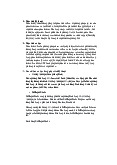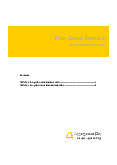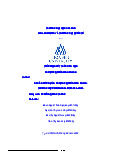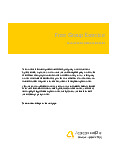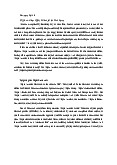



















Preview text:
SCHOOL OF WESTERN SYDNEY GROUP ASSIGNMENT COVER SHEET STUDENT DETAILS Student Student ID name: Phạm Quế Nhi number: 22002962 Student Student ID name: Trần Đỗ Phương Anh number: 22003430 Student Student ID name: Nguyễn Ngọc Bảo Trân number: 21001110 Student Student ID name: Nguỵ Gia Hân number: 21001431 Student Student ID name: Ngô Anh Thư number: 22003180 Student Student ID name: Lê Trường Giang number: 22003467 UNIT AND TUTORIAL DETAILS Unit Unit name: International Business number: IB-T223WSB-4 Tutorial/ Lecture:
Class day and time: Friday,15:30-18:45 Lecturer or Tutor name: Adam Briffett ASSIGNMENT DETAILS Title: Group Report Due Date Length: 2176 words date: 11/08/2023 submitted: 10/8/2023 Home campus (where you are enrolled): 196 Trần Quang Khải DECLARATION
I hold a copy of this assignment if the original is lost or damaged.
I hereby certify that no part of this assignment or product has been copied from
any other student’s work or from any other source except where due
acknowledgment is made in the assignment.
I hereby certify that no part of this assignment or product has been submitted
by me in another (previous or current) assessment, except where
appropriately referenced, and with prior permission from the Lecturer / Tutor /
Unit Coordinator for this unit.
No part of the assignment/product has been written/produced for me by any
other person except where collaboration has been authorised by the Lecturer /
Tutor /Unit Coordinator concerned.
I am aware that this work will be reproduced and submitted to plagiarism
detection software programs for the purpose of detecting possible plagiarism
(which may retain a copy on its database for future plagiarism checking). Student’s signature: Nhi Student’s signature: Anh Student’s signature: Trân Student’s signature: Hân Student’s signature: Thư Student’s signature: Giang
Note: An examiner or lecturer / tutor has the right to not mark this assignment if the
above declaration has not been signed. INTERNATIONALBUSINESS [IB-T223WSB-4] BUS302 Lecturer: Adam Briffett MNCREPORT GUCCI Group 1: 1. Trần Đỗ Phương Anh 2. Phạm Quế Nhi 3. Nguyễn Ngọc Bảo Trân 4. Ngụy Gia Hân 5. Ngô Anh Thư 6. Lê Trường Giang I.EXECUTIVESUMMARY
From the dazzling red carpet of Paris fashion week to the daily casual wearer, fashion grabs
everyone's attention. Gucci, a leading luxury goods merchant, began as a small family-owned business in 1921 Italy.
Gucci has targeted worldwide prominence, serving regional and international clientele, under
numerous creative directors. Managing local demands and global product lines.Gucci wants to be
a cultural icon, fashion leader, and driving force. Gucci strives to create unique designs that
enhance client experiences. The brand enjoys developing trends and spreading them to broad consumers.
Accordingly, Gucci's presence has expanded across 55+ countries through subsidiaries, exports,
and joint ventures. This growth, however, has faced setbacks, including environmental, political,
and economic challenges. As the brand persists in its expansion, more hurdles inevitably lie ahead.
This report is dedicated to dissecting and addressing these challenges, presenting practical
solutions to bolster Gucci's growth and development. While not foolproof, these solutions aim to aid the company's progress. II.INTRODUCTION
The early 21st century has witnessed economic upheavals, demographic shifts, and remarkable
technological advancements. These changes signify a transformative era, reshaping the business
landscape and consumer dynamics.
Industries spanning from F&B (superfoods) to tech (AI) and healthcare (telemedicine) are
experiencing profound shifts, underscoring the necessity of innovation for survival. The fashion
realm, exemplified by Gucci's history, echoes this demand for evolution.
Today, navigating unprecedented challenges requires Gucci to strategically leverage its potential
and avert decline in a swiftly evolving landscape. III.COMPANYSTRATEGY A.CurrentStrategy
Proper selection of international strategies is a crucial component for multinational companies to
confront significant changes in the global market such as distinctive customer preferences and
the fierce rivalry among corporations (Hitt et al., 2016). Gucci has also perceived these values
and performed its operation following the transnational strategy to enter foreign markets.
Complying with the strategy's objectives, the company attempts to respond to users’ needs in
different geographical locations while still ensuring high-quality materials, skilled artisans, and
differentiated products (Gucci, 2023).
Particularly, Gucci optimally uses methods to reach economies of scale and satisfy local tastes.
Firstly, the company strives to standardize its official sites using different languages. Ciocca
(2020) declared in a study that most customers feel better at simplicity and security when they
make purchases in their own language. Thus, this practice might allow the brand to boost
revenue and approach a wider range of customers. Secondly, Gucci leverages its customer profile
system including demographics, geographic and interest databases to analyze general
consumption patterns in a region. The brand consequently can launch and recommend
appropriate product lines matching with local customers (Gucci, 2023). For example, Gucci
places most beauty stores in some Asian nations like Japan and Korea instead of others as there
is high demand from users. Additionally, Gucci carefully filters and cooperates with celebrities
who might help the company achieve better interaction with local customers.
Following the strategy, Gucci implements sustainable activities such as using renewable energy,
upcycling materials leftover, and so on (Gucci, 2023a). In turn, they might reduce significant
expenses in the production process. Noticeably, the company takes advantage of some specific
countries to produce more efficiently. Its timepieces, in particular, are made in Switzerland which
is well-known for the “beating heart” of the watch industry and possesses skilled watchmakers
(Nast, 2021). Other products also made outside of Italy include cosmetics in the EU and some
eyewears in Japan. Ultimately, Gucci constantly seeks a network of reputable suppliers and
collaborates closely with them to get quality inputs (Gucci, 2021). Consequently, upholding
these things might help Gucci acquire a cost and quality competitive edge in competing with other luxury brands. B.EntryMode
Bui et al. (2022) approved in a study that the route of entrance is one of the most important
factors defining a firm's foreign expansion strategy's success or failure. As a major player in the
luxury fashion industry, Gucci enters the worldwide market using different means, including
wholly owned subsidiaries, exporting, and joint ventures. Following the notion of ownership
entry mode, Gucci focuses on a greenfield ventures approach, meaning that the business
constructs new facilities such as factories, headquarters, and stores in targeted markets to run its
operations. For instance, the brand establishes a manufactory directly executed by Kering Group
for its timepieces product line in Switzerland (Douglas, 2022). Similarly, until now there are 3
operated Gucci stores in the Vietnam market and 525 offline-bases in the rest of the world
(Statista, 2022). In addition, Gucci also combines with exporting mode to distribute its items that
are produced exclusively in some countries to different markets across the world. Furthermore, it
chooses to associate with partnerships in specific regions to build joint companies. Hence, it is
beneficial for Gucci to mark its presence in the entering markets. It was also reported by Douglas
that the brand and SSI Group officially collaborate with each other to build Luxury Goods
Philippines Inc (LGPI) that aims to improve Gucci and SSI's collaboration and is projected to
boost the expansion of the Gucci brand in the Philippines and its operational efficiencies (Cordero, 2022).
Figure1:NumberofdirectlyoperatedGuccistoresworldwidein2022
IV.ENVIRONMENTALANALYSIS&IDENTIFICATIONOFGUCCIISSUES A.MicroEnvironmentAnalysis 1.Company
CorporateCulture:Collaboration and innovation:
In its official website, Gucci dedicates itself to creating a strong corporate culture emphasized on
collaboration and innovation, it aims to foster an encouraging, inclusive and respectful yet bold environment for its employees.
Being in a turbulent industry such as fashion means flexibility and innovations were always top
priorities for Gucci. Due to these reasons, Alessandro Michele, the then creative director of
Gucci made a momentous decision in 2015 to transform the brand’s image from an exclusive
retailer into a cultural icon within the fashion industry (Wanick et al., 2023). Fusing arts, cultures
and luxury fashions in an attempt to reinvent the company’s culture. (Our CorporateCulture– GucciEquilibrium, n.d.) 2.Competitors
According to He and Deng, differentiation has progressed from its basic purpose as a strategic
marketing tactic to becoming an essential step in distinguishing a product from comparable
products or even prospective alternatives in the marketplace (2020). As a result, Gucci and its
famous competitors completely appreciate this notion, with each brand characterized by a particular design style.
According to (Appendix A), Gucci and Hermès portray themselves as current and stylish
businesses that are constantly tied to the newest global trends. While Gucci pushes for more
contemporary and appealing designs, Hermès always supports remarkable comments in their
goods. Louis Vuitton and Prada, on the other hand, adopted a conventional yet attractive
aesthetic. Coincidentally, all four luxury fashion industry titans have kept their premium pricing
approach from the outset to the present, and their ability to retain vast numbers of devoted clients is obvious.
Although both brands had similarities in terms of proposed pricing and claimed quality, each
brand introduced a unique product line upon entering the global market. However, the main
determinant of which brand offers the most comprehensive range of products is the variation in
the additional things available from each brand. While Prada primarily emphasizes the
aforementioned fundamental products, Hermès is renowned for its extensive range of home
furnishings and innovative house remodeling concepts. In contrast, Louis Vuitton is recognised
for its additional offerings of books and extensive selection of stationery goods. Gucci's portfolio
encompasses a diverse range of goods, including children's ready-to-wear apparel and
accessories, well sought-after perfumes, high-end cosmetic offerings, and innovative home furnishings and decor. 3.Consumers
Gucci's demographic, geographical, behavioral, and psychological target groups are wealthy and
privileged. Consumer preferences have gotten more complicated due to their roots, which create
a complex and high-standard need for luxury items, and competition from other brands (Hennigs
et al., 2015). Despite Gucci's long-standing presence and development in the premium fashion
sector, customers' high requirements for this brand remain imaginative and clever. This increased
complexity is due to consumers' conspicuous motivations to buy luxury products, which are
linked to their lifestyles and affluence (Hennigs et al., 2015). Thus, luxury brands must provide
quality, service, and the best designs to satisfy customers, build trust, and earn loyalty (Hennigs et al., 2015). B.Issue 1.Strategy
Transnational companies often receive criticism for their harm to the environment. Gucci needs
to address sustainability concerns by implementing eco-friendly practices throughout its supply
chain and ensuring ethical sourcing of materials. The issue of fashion companies making false
carbon neutral claims is a growing concern within the industry. Failure to do so may lead to
reputational damage and loss of customers. (Don-Alvin , 2023) 2.Macro
Political factor : International trade agreements, tariffs, and trade restrictions influence Gucci's
global supply chain, manufacturing costs, and export/import activities.
Legal Factors: Gucci's brand reputation relies on protecting its designs, trademarks, and patents
from counterfeiting and intellectual property violations. However, intellectual properties and
design copyright are major legal issues that Gucci has been facing. 3.Micro
Competitors: Gucci does not have the "first-mover advantage". The first luxury fashion brand to
enter the Vietnamese market is Louis Vuitton, followed by Dior, Hermes, Burberry, Kering.
These brands offer a wide range of high-end goods and each has their own unique style,
craftsmanship, and brand image. Therefore, Gucci should consider them as its fierce competitors.
Ethics: Recently, Gucci has faced a wave of boycotts because they used some images that are
considered sensitive in their advertisement such as the Gucci Ha Ha Ha campaign. This
advertising is facing controversy when it comes to the idea of children in the campaign. The
audience thinks that this is the exploitation of the child element in advertising (Keller, 2022). V.RECOMMENDSOLUTIONS A.Strategy
The environmental concern in the fashion industry is considerably higher than any other
industries as the industry carries a high risk of environmental damage, particularly water
pollution and solid waste. (Lan et al., 2023).
Vietnam also enforces legislation to address environmental concerns in fashion-related
businesses (Lan et al., 2023). Gucci needs to inspect closely and thoroughly the transparency and
credibility of its sustainability initiatives, such as verifying their activities and certifying their
carbon offsets, can help identify companies that are truly committed to reducing their
environmental footprint (Don-Alvin, 2023). By doing this, Gucci will enhance its brand
reputation, attract conscious consumers, while also aligning with global sustainability goals B.MacroEnvironment Politicalfactor:
International trade agreements, tariffs, and trade restrictions influence Gucci's global supply
chain, manufacturing costs, and export/import activities. Gucci has to maintain a close watch on
geopolitical changes and proactively minimize risks by diversifying its suppliers and
manufacturing facilities. Gucci should also monitor any changes in governmental regulations that
may have an effect on the luxury market and alter its strategies as necessary. LegalFactors:
Gucci's brand reputation relies on protecting its designs, trademarks, and patents from
counterfeiting and intellectual property violations. Counterfeit products not only affect revenue
but also dilute the brand's exclusivity and authenticity. Gucci should work on strengthening
Legal Measures by collaborating with relevant authorities, for instance, Anti-Smuggling
Investigation to detect and handle violations of counterfeit goods, goods infringing intellectual
property and violations of origin. Or legal experts to enhance intellectual property protection and
enforce stricter penalties for counterfeiters, like file lawsuits against sale of counterfeit goods
(Lee et al, 2021). And last but not least, educate consumers about the risks associated with counterfeit products. C.MicroEnvironment
Gucci's success in the face of Louis Vuitton, Dior, Hermes, and Burberry is due to its emphasis
on the consumer experience. Through a special event called Cine Gucci, Gucci offers its loyal
consumers a brand-new experience in which they are welcomed in a very luxurious setting and
receive the highest level of care, including watching performances by famous artists, receiving
private consultations in a hidden room, and having their own clothing tailored to fit them
perfectly (Nguyên, 2022). Gucci also provides a large selection of goods that suit Vietnamese
demands and interests. To create items that fit Vietnamese consumers' needs, they perform
market research to understand local consumer behavior, cultural quirks, and fashion trends.
Moreover, Gucci should maintain clear channels of communication with the public throughout
the advertising process. They should offer updates on the steps they are taking to resolve the
issues, as well as demonstrate their commitment to ethical advertising. Addressing the issue
openly will help in the restoration of trust and the maintenance of a positive brand image. VI.CONCLUSION
In conclusion, Gucci has transformed from a small family-owned company to a more luxury
retailer, known for its innovative designs and commitment to enhancing customer experiences.
The company has expanded its operations in various countries, despite facing challenges from
environmental, political, and economic issues. This report identifies these problems and provides
solutions to support Gucci's expansion and improvement. Sustainability, ethical practices, and
transparent supplier chains are crucial for solving existing challenges and ensuring a positive
impact on society and the environment. Gucci must remain committed to defining trends,
reaching diverse consumers, and being aware of its global impact to solidify its position as a
fashion industry leader and capture the attention of fashion fans worldwide. I. REFERENCELIST
Beresford Research. (2023). AgeRangebyGeneration. Beresford Research.
https://www.beresfordresearch.com/age-range-by-generation/
Bhasin, H. (2023, March 28). SWOTanalysisofGucci-GucciSWOTanalysisandInternal
analysis. Marketing91. https://www.marketing91.com/swot-gucci/
Bui, L., Hoang, H., & Bui, H. (2022). EntryModeChoiceandPerformanceofForeignDirect
InvestmentFirmsinEmergingEconomies:Micro-evidencefromVietNam. Economic
Research Institute for ASEAN and East Asia - ERIA.
https://www.eria.org/publications/entry-mode-choice-and-performance-of-foreign-direct-i
nvestment-firms-in-emerging-economies-micro-evidence-from-viet-nam/
Ciocca, M. (2020). Online Product Localization: Challenges and Solutions in Global Online
Marketplaces. DigitalandSocialMediaMarketing, 275–282.
https://doi.org/10.1007/978-3-030-24374-6_19 CODE OF ETHICS. (n.d.). In . Gucci.com
https://www.gucci.com/documents/Kering_CodeEthique2019_English.pdf
Cordero, T. (2022). SSI,Gucciformjointventurecompany. GMA News Online.
https://www.gmanetwork.com/news/money/companies/832196/ssi-gucci-form-joint-vent ure-company/story/
DeAcetis, J. (2020, October 4). HowTechnologyIsHelpingLuxuryFashionBrandsGain Traction. Forbes.
https://www.forbes.com/sites/josephdeacetis/2020/10/04/how-technology-is-helping-luxu
ry-fashion-brands-to-gain-traction/?sh=7d4d9c923640
Disko. (2019). Financialpublications. Kering.com.
https://www.kering.com/en/finance/publications/
Don-Alvin , A. (2023, May 18). Notsocarbonneutral:Gucciadjustssustainabilitygoals. FashionUnited.
https://fashionunited.uk/news/fashion/not-so-carbon-neutral-gucci-adjusts-sustainability- goals/2023051869634
Douglas , A. (2022). Gucci’shighhorologyhasitstandoutfromthecrowd. Watchpro.
https://www.watchpro.com/guccis-high-horology-has-it-stand-out-from-the-crowd/#:~:te
xt=25%20watch%20calibre%20is%20produced,%2Dde%2DFonds%2C%20Switzerland.
Ecobuildings–GucciEquilibrium. (2021, July 13). GUCCI US Official Site.
https://equilibrium.gucci.com/eco-buildings/
Gucci. (2021, July 13). Responsiblesupplychain–GucciEquilibrium. Gucci Equilibrium.
https://equilibrium.gucci.com/responsible-supply-chain/
Gucci. (2023). Gucci’snature-positivevision:Fromthegrounduptocollections. Gucci Equilibrium.
https://equilibrium.gucci.com/guccis-nature-positive-vision-from-the-ground-up-to-collec tions/
Gucci . (2023). FAQ’s|GucciOfficialSite. Gucci.com.
https://www.gucci.com/us/en/st/faq#sustainability
GucciandFacebookfilejointlawsuitagainstallegedcounterfeiter. (2021, April 27). CNBC.
https://www.cnbc.com/2021/04/27/gucci-and-facebook-file-joint-lawsuit-against-alleged- counterfeiter.html
Gucci’snature-positivevision:fromthegrounduptocollections–GucciEquilibrium. (2022). Gucci Equilibrium.
https://equilibrium.gucci.com/guccis-nature-positive-vision-from-the-ground-up-to-collec tions/
Hartmans, A. (2022, August 6). ThewealthyaresplurgingonFerraris,Guccihandbags,and
expensiveChampagne,whileMcDonald’scustomerscan’taffordcombomeals. Business Insider.
https://www.businessinsider.com/gucci-louis-vuitton-owners-kering-lvmh-earnings-stron g-amid-inflation-2022-8
He, D., & Deng, X. (2020). Price Competition and Product Differentiation Based on the
Subjective and Social Effect of Consumers’ Environmental Awareness. International
JournalofEnvironmentalResearchandPublicHealth, 17(3), 716.
https://doi.org/10.3390/ijerph17030716
Hennigs, N., Wiedmann, K.-P., Klarmann, C., & Behrens, S. (2015). The complexity of value in
the luxury industry. InternationalJournalofRetail&DistributionManagement,
43(10/11), 922–939. https://doi.org/10.1108/ijrdm-07-2014-0087
Hitt, M. A., Li, D., & Xu, K. (2015). International strategy: from Local to Global and beyond.
JournalofWorldBusiness, 51(1), 58–73. ResearchGate.
https://doi.org/10.1016/j.jwb.2015.08.016
Kasztalska, A. M. (2018). BRAND IMAGE AND THE FIGHT AGAINST COUNTERFEITING
BY THE GUCCI COMPANY. CBUInternationalConferenceProceedings, 6(6. 221.
10.12955/cbup.v6.1160.), 221–225. https://doi.org/10.12955/cbup.v6.1160
Keller, E. (2022, December 19). GucciandHarryStylesslammedfor“sick”adwithchild’sbed
andteddybearshirt. New York Post.
https://nypost.com/2022/12/19/gucci-and-harry-styles-slammed-for-sick-ad-with-childs-b ed-and-teddy-bear-shirt/
Kirby, J. (2023, February 22). Gucci Launches Sustainability Drive as European Fashion
Regulation Looms. WallStreetJournal.
https://www.wsj.com/articles/gucci-launches-sustainability-drive-as-european-fashion-re gulation-looms-65612f25
Lan, D. C., Diep, L. T. B., Hien, V. T. T., Tu, T. N., & Tilleke & Gibbins. (2023, August).
FashionLaw. Www.globallegalpost.com.
https://www.globallegalpost.com/lawoverborders/fashion-law-2116409480/vietnam-1779 580504
Lee, L. Z., Zargani, L., & Lee, A. (2021, April 27). Gucci,FacebookFileJointLawsuitin CounterfeitFight. WWD.
https://wwd.com/business-news/legal/gucci-facebook-file-joint-lawsuit-counterfeit-fight- 1234810544/
Martha. (2023). AGucciFranchiseIsAVeryExpensiveInvestmentGucci:ALuxuryFashion
BrandWithAHigh-EndPricePoint. Icsid.org.
https://www.icsid.org/uncategorized/a-gucci-franchise-is-a-very-expensive-investment-gu
cci-a-luxury-fashion-brand-with-a-high-end-price-point/
McKeever, V. (2022, February 17). LuxurygoodsgroupKeringconfidentGuccisalesgrowth
willcontinueafterbumper2021revenues. CNBC.
https://www.cnbc.com/2022/02/17/kerings-pinault-confident-on-guccis-growth-as-group- revenues-up-35percent.html
Nast, C. (2021). 18SwissWatchBrandsYouAbsolutelyNeedtoKnow. Gq.
https://www.gq.com/story/swiss-watch-brands
O’connor, T. (2022, March 4). UnpackingLuxury’sResponsetotheWarinUkraine. The Business of Fashion.
https://www.businessoffashion.com/briefings/global-markets/unpacking-luxurys-response -to-the-war-in-ukraine/
Office of the U.S. Intellectual Property Enforcement United States. (2010). JUNE201 . 0
https://www.whitehouse.gov/wp-content/uploads/2022/09/2010-Joint-Strategic-Plan-on-I
ntellectual-Property-Enforcement.pdf
OurCorporateCulture–GucciEquilibrium. (n.d.). Gucci Equilibrium.
https://equilibrium.gucci.com/our-corporate-culture/
Singh, N., Furrer, O., & Ostinelli, M. (2004). To Localize or to Standardize on the Web:
Empirical Evidence from Italy, India, Netherlands, Spain, and Switzerland. Multinational
BusinessReview, 12(1), 69–88. https://doi.org/10.1108/1525383x200400004
Statista. (2022). NumberofdirectlyoperatedGuccistoresworldwidein2022,byregion. Statista; Statista.
https://www.statista.com/statistics/442796/number-of-gucci-stores-worldwide-by-region/
Statista. (2023, February 24). GlobalrevenueoftheKeringGroup,bybrand2012-2018|
Statistic(T. Sabanoglu, Ed.). Statista; Statista.
https://www.statista.com/statistics/267476/global-revenue-of-the-kering-group-by-brand/
Swant, M. (2020). The2020World’sMostValuableBrands. Forbes.
https://www.forbes.com/the-worlds-most-valuable-brands/#5ab0b365119c
SWOTAnalysisofGUCCI–SWOTAnalysisofGUCCI[Detailed]. (2022). Projects4MBA.
https://www.projects4mba.com/swot-analysis-of-gucci/4582/
Thảo, N. (2022). CineGucci:Một“cúchạm”đỉnhcaocủaGucciđếnthịtrườngxaxỉViệtNam.
L’Officiel Vietnam | the Fashion Revolution.
https://www.lofficielvietnam.com/business/hinh-cine-gucci-o-viet-nam-bao-hieu-gi-cho-t
hi-truong-thoi-trang-cao-cap-noi-dia
Wanick, E. B., Lee, Y.-A., Turrini, M. M., Cedrola, B. E. J., & Cedrola, B. J. (2023). Palgrave
StudiesinPractice:GlobalFashionBrandManagement. SpringerLink.
https://link.springer.com/series/14598
Zigu. (2023, June 2). GucciSWOTAnalysis|TopGucciCompetitors&USP|BrandAnalysis|
MBASkool-Study.Learn.Share.MBA Skool-Study.Learn.Share.
https://www.mbaskool.com/brandguide/lifestyle-and-retail/2645-gucci.html II. APPENDIX AppendixA: Competitors Gucci LouisVuitton Prada Hermes PrimaryDistinction Charming Classical Innovation Modern Classy Elegance Elegance Clasy Contemporary Style Daring PricingStrategy Premium Premium Premium Premium Superior quality Superior quality Superior quality Superior quality Quality Premium women's, Stylish apparel, Expensive apparel, Furniture, Theassortmentof men's, and kids' men's and jewelry, and other electronics, and itemsavailable apparel and women's accessories for both appliances; in accessories, as well accessories, genders. addition to high-end as perfumes, jewelry, and apparel for men & cosmetics, and books. women. furnishings. . Targetmarket Person of moderate Affluent Individuals who own Middle-aged persons age who is affluent individuals in substantial financial who hold prominent and lives in a large
their middle years. resources and possess positions and possess city. a high level of substantial wealth. Young generation. intellectual capacity. Artistic trendsetters. AppendixB:SWOT Analysis: STRENGTHS: WEAKNESSES:
Gucci has shown a consistent and enduring presence of In addition to its ongoing research and development
brand equity throughout the course of its commercial endeavors, Gucci prioritizes substantial investments in operations (Bhasin, 2023).
order to implement enhancements or initiatives aimed
at safeguarding its enduring reputation (Zigu, 2023).
According to Forbes, Gucci has achieved significant
success in establishing a robust and enduring brand The distinct characteristics of Gucci, as well as its
equity, securing the 31st position among the top 50 most advertising campaigns, have been known to
valuable brands globally in 2020. It is estimated that periodically incite disagreements or elicit criticism from
Gucci's brand value amounts to around $US 22.6 billion customers worldwide. Numerous problems have arisen (Swant, 2020).
over the sensitive advertising of this company,
particularly the one with a child's bed and a teddy bear
Corporate Social Responsibility (CSR) has significance clothing, which ultimately led to significant
in the context of Gucci's engagement in various CSR condemnation from viewers (Bhasin, 2023; Keller,
endeavors. Notably, Gucci has established a noteworthy 2022).
partnership with UNICEF, whereby the company actively
contributes to the welfare of children globally (Zigu, Counterfeit goods have been prevalent worldwide for 2023).
an extended period of time, as shown by Zigu (2023). OPPORTUNITIES: THREATS:
Gucci has the ability to identify a hitherto untapped Gucci's principal concern is on the substantial growth
market demographic - the younger generation. The of its rivals, namely prominent luxury fashion labels
current cohort of consumers, consisting of both like Louis Vuitton, Chanel, Dior, and Hermes.
Millennials (born between 1981 and 1996) and Gen Z
(born between 1997 and 2012), are displaying heightened The success of a global brand like Gucci may be
brand consciousness and a growing desire to own luxury significantly impacted by several factors, including but
goods. This trend can be attributed to the gradual not limited to, unanticipated changes in national
increase in financial resources and stable career legislation or policies, variations in currency exchange
trajectories among Millennials and Gen Z (Bhasin, 2023; rates, economic recessions, pandemics, and natural Beresford Research, 2023).
catastrophes. These external factors can have both
direct and indirect effects on the brand, leading to a loss
In addition to its established markets in the United States in revenue. (Zigu, 2023; Statista, 2023)
and Europe, Gucci is seeing an increasing presence in
quickly rising markets like China, India, and affluent
Middle Eastern nations, particularly Dubai and the
United Arab Emirates. These markets are gradually
evolving into significant consumers of Gucci products,
characterized by their substantial consumption volumes (SWOT Analysis…, 2022).
AppendixC: Macro Environment Analysis (PESTEL Analysis) Political
The ability to conduct business in a nation depends on its political stability, which is essential for
an organization's expansion. Due to the conflict that Russia started, Gucci decided to stop doing
business there (O'Connor, 2022). Sustainable trade relations are essential to the manufacturing
process of high-end fashion, and when those relationships are disrupted, Gucci's supply of raw
materials and finished goods may suffer. The amount of tax charged on the company's goods in
the international market has an effect on its income and profitability because greater taxes might
result in higher pricing and prevent customers from making purchases. Legalfactors
Gucci’s home country is Italy and it follows a civil law system. Gucci's business activities may
be impacted by legal factors including labor laws, health and safety rules, and environmental
restrictions. Gucci additionally has to comply with intellectual property laws to safeguard its
trademarks and patents. Following a trial, two defendants were found guilty in June 2010 of
bringing into the country from China more than 300,000 luxury handbags and wallets that were
not authentic and stolen trademarks from companies like Burberry, Louis Vuitton, Gucci, Coach,
Fendi, Chanel, and others (Office of the U.S. Intellectual Property Enforcement United States, 2010). Economicfactors
Recession and inflation are examples of economic elements that have an impact on numerous
organizations because they increase their desire for capital and result in price adjustments.
Although sales were anticipated to suffer, demand for Gucci's products has not decreased much,
in part because the wealthy target demographic has not been impacted by price increases
(Hartmans, 2022). Despite continuing inflation, Gucci's sales increased by 31% (McKeever, 2022). Social&demographicfactors
Gucci has a reputation for setting the pace for fashion trends, and social trends have a significant
impact on the fashion business. The success of the business depends on its capacity to develop
goods which are attractive to many socioeconomic groups. Gucci's products are known for their
high level of luxury and social prestige, and the company's marketing approach supports this
perception. Gucci's market position, however, may be threatened by shifting social perceptions of
fashion, such as the rising desire for sustainable and ethical fashion.
